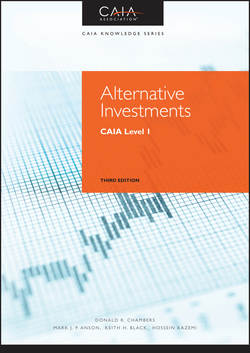Читать книгу Alternative Investments - Hossein Kazemi - Страница 23
На сайте Литреса книга снята с продажи.
PART One
Introduction to Alternative Investments
CHAPTER 1
What Is an Alternative Investment?
1.7 Goals of Alternative Investing
ОглавлениеHaving defined what alternative investments are from a variety of perspectives, we introduce the questions of how and why people pursue alternative investing. Understanding the goals of alternative investing is essential; the following sections provide an introduction to the most important of these goals.
1.7.1 Active Management
Active management refers to efforts of buying and selling securities in pursuit of superior combinations of risk and return. Alternative investment analysis typically focuses on evaluating active managers and their systems of active management, since most alternative investments are actively managed. Active management is the converse of passive investing. Passive investing tends to focus on buying and holding securities in an effort to match the risk and return of a target, such as a highly diversified index. An investor's risk and return target is often expressed in the form of a benchmark, which is a performance standard for a portfolio that reflects the preferences of an investor with regard to risk and return. For example, a global equity investment program may have the MSCI World Index as its benchmark. The returns of the fund would typically be compared to the benchmark return, which is the return of the benchmark index or benchmark portfolio.
Active management typically generates active risk and active return. Active risk is that risk that causes a portfolio's return to deviate from the return of a benchmark due to active management. Active return is the difference between the return of a portfolio and its benchmark that is due to active management. An important goal in alternative investing is to use active management to generate an improved combination of risk and return.
Active management is an important characteristic of almost all alternative investments. Unlike traditional investing, in which the focus is often on security analy- sis and passive portfolio management, the focus of alternative investing is often on analyzing the ability of the fund to generate attractive returns through active management.
1.7.2 Absolute and Relative Returns
The concepts of benchmark returns, absolute return products, and investment diversifiers have been briefly introduced in this chapter. Let's examine these and other concepts in more detail. In alternative investing, there are two major standards against which to evaluate returns: absolute and relative.
An absolute return standard means that returns are to be evaluated relative to zero, a fixed rate, or relative to the riskless rate, and therefore independently of performance in equity markets, debt markets, or any other markets. Thus, an investment program with an absolute return strategy seeks positive returns unaffected by market directions. An example of an absolute return investment fund is an equity market-neutral hedge fund with equal-size long and short positions in stocks that the manager perceives as being undervalued and overvalued, respectively. The fund's goal is to hedge away the return risk related to the level of the equity market and to exploit security mispricings to generate positive returns.
A relative return standard means that returns are to be evaluated relative to a benchmark. An investment program with a relative return standard is expected to move in tandem with a particular market but has a goal of consistently outperforming that market. An example of a fund with a relative return strategy is a long-only global equity fund that diversifies across various equity sectors and uses security selection in an attempt to identify underpriced stocks. The fund's goal is to earn the benchmark return from the fund's exposure to the global equity market and to earn a consistent premium on top of that return through superior security selection.
1.7.3 Arbitrage, Return Enhancers, and Risk Diversifiers
The concept of arbitrage is an active absolute return strategy. Pure arbitrage is the attempt to earn risk-free profits through the simultaneous purchase and sale of identical positions trading at different prices in different markets. Modern finance often derives pricing relationships based on the idea that the actions of arbitrageurs will force the prices of identical assets toward being equal, such that pure arbitrage opportunities do not exist or at least do not persist. Chapter 6 provides details on arbitrage-free modeling.
The term arbitrage is often used to represent efforts to earn superior returns even when risk is not eliminated because the long and short positions are not in identical assets or are not held over the same time intervals. To the extent that investment professionals use the term arbitrage more loosely, these investment programs can be said to contain active risk and to generate relative returns.
An obvious goal of virtually any investor is to earn a superior combination of risk and return. If the primary objective of including an investment product in a portfolio is the superior average returns that it is believed to offer, then that product is often referred to as a return enhancer. If the primary objective of including the product is the reduction in the portfolio's risk that it is believed to offer through its lack of correlation with the portfolio's other assets, then that product is often referred to as a return diversifier.
